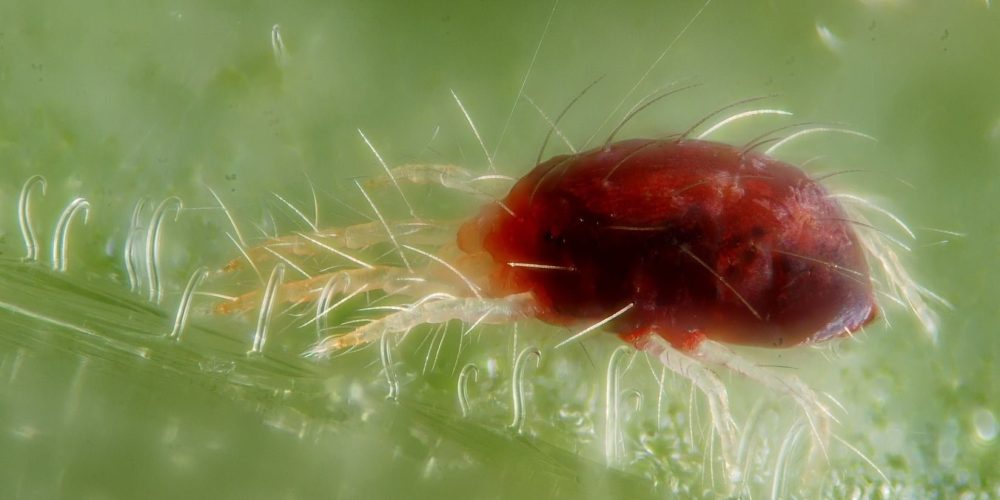Table of contents of the article
ToggleTwo-spotted spider mite is a serious pest of many agricultural crops, causing leaf damage and productivity deterioration. In this article on your website, World of Plants, we review methods of prevention and treatment.
Symptoms of the two-spotted spider mite
- Name of the disease: The red two-spotted spider Tetranychus telarius
- Scientific name: Tetranychus telarius L
- Type: spider
- Disease family: Tetranychidae
It is fed by sucking plant sap through proboscis-shaped mandibles, usually in the cells of the lower surface of the leaf.
Symptoms of damage appear on the upper surface The leaf has spots White or yellow, and with continued feeding, these spots turn brown.
The mite secretes tissue Arachnid As it moves over the plant, the leaves appear covered with a dense silky mesh on which dust and dirt collect. The mites move between the hairs on the lower surface of the leaves like scattered grains of sand.
It affects leaves and flowers Fruits lead to a decrease in yield, such as beans and eggplant And cucurbits. As for ornamental plants, they lose most of their leaves after they dry up and die.
The leaves wilt and dry when the infection is severe and fall, and severe infection may lead to the death of the plant.
Causes of two-spotted spider mite
Poor irrigation, high or low humidity, severe winds, drought, or damage to the root system can cause an increase in the damage resulting from infection with this pest.
Suitable conditions for the spread of the two-spotted spider mite
The appropriate temperature for growth and development ranges between 12-40 degrees Celsius. The time period from egg to adult animal takes less than a week at the optimum temperature of 30-32 degrees Celsius. Males grow and develop faster than females.
The humidity is between 50-70%.
The development cycle of the two-spotted spider mite
It is found throughout Egypt throughout the year, and does not hibernate. The female lays her eggs individually, and the total amount she lays is about 50 to 150 eggs in one week. The period of laying eggs may last a month depending on the high or low temperature, and the animal lives with this from one week to Two weeks in the summer and more than four months in the winter.
- The egg hatches after about three days in the summer and twenty days in the winter.
- After hatching, the larvae - as previously mentioned - have three pairs of legs, which become four after the first moult when they become the first nymph.
- The first nymph molts to form the second nymph, and when the second nymph molts, males and females emerge, and males often appear before females in one generation.
- The life cycle takes a week in the summer and about two months in the winter.





Losses of disease spread
- This species is known under many names, including the two-spotted red mite, the greenhouse mite, and the simple red spider mite. It is considered one of the most widespread mites in the world.
- It is spread in many Arab countries, including Yemen. It has also been recorded in Europe, Asia, Africa, Australia, the Caribbean and Atlantic Islands, North, Central and South America.
Control strategy
- Mechanical control
- Physical control (tillage, sanitation, pruning, solarization)
- Insecticides
Preventive measures to prevent the occurrence of the disease
Deep plowing of the soil after harvest to encourage dormant individuals.
Trees must be followed and examined with magnifying glasses to identify signs of infection and estimate the number of pests.
Excessive use of pesticides should be avoided because of its negative impact on natural enemies.
Watering should be taken care of and avoid overexposing Trees to drought.
Pruning must be done so as to avoid the branches coming into contact with the surrounding weeds on the soil surface
Spray plants with specialized pesticides.
Chemical control recommendations
- Fenbutatin-oxide
- Fenpyroximate
- Pyridaben
- Abamectin
Anti-membership recommendations
Vitality:
Among the most important types of predators: From the Phytoseiidae family there are Galemdromus occidentalis, Neoseiulus californicus, N.fallacis, N.longispinosus, Phytosielus persimilis, P.micropilis
The small flies Feltiella acarisuga are commercially available in many countries of the world.
Ladybirds belonging to the genus Stethorus, the most important of which is S.punctillum.
Hemipteran predators such as Macroloplus and caliginosus.
Other insect predators include ants Tapinoma melanocephalum and Scolothrips sexmaculatus. It is adapted to hot and dry weather.
– Fungi such as Entomophthora thaxteriana E.adjarica, which are effective in very humid climates within covered crops.
Plant extracts:
The results of laboratory biological tests showed a significant effect of garlic and wheat extracts. No differences were observed between these plant extracts and the acaricides used after 72 hours.
The results of the study also showed that extracts of Stactus officinalis L. and Melia azedarach L. have a good degree of effect in controlling the pest in tomatoes.
In conclusion, we would like to note that we, at the world of plants website, offer you all the necessary services in the world of plants, we provide all farmers and those interested in plants with three main services::-
- Artificial intelligence consulting service to help you identify diseases that affect plants and how to deal with them.
- Blog about plants, plant diseases and care of various crops ... You are currently browsing one of her articles right now.
- An application that provides agricultural consultations to clients, as well as a service for imaging diseases and knowing their treatment for free – Click to download the Android version from Google Play Store، Click to download the IOS version from the Apple App Store.
the reviewer :
The red two-spotted spider Tetranychus telarius (L.) - almerja
Tow Spotted spider Mite - alnabate




